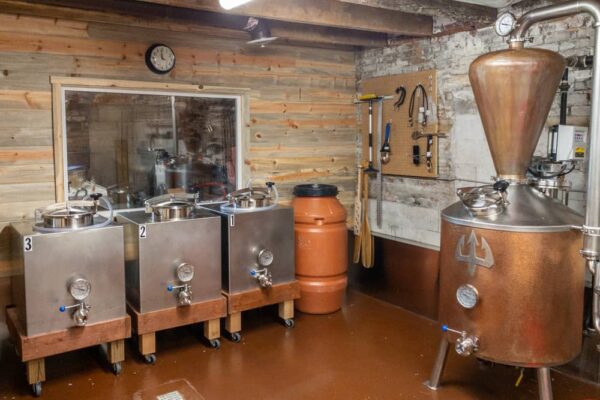Located in southern Westmoreland County, West Overton Village is an incredible 19th-century village that offers visitors the chance to find out more about life on the Pennsylvania frontier.
The village was founded in 1800 by Henry Overholt, a German Mennonite from eastern PA. Overholt founded a rye whiskey distillery on the site, which soon became popular and enabled the community of West Overton to thrive and become completely self-sufficient.
In 1849, probably the most notable event in community history occurred when Henry Overholt’s great-grandson was born. His great-grandson, who would spend much of his first 30 years in West Overton was Henry Clay Frick, one of the most well-known industrialists in Western Pennsylvania history.

It is thanks to Frick’s daughter, Helen Clay Frick, that West Overton Village was preserved in 1928 when she bought the site to help memorialize her father, just as she did when she bought his home in Pittsburgh and turned it into the Frick Museum.
Over the years, West Overton Village has grown to not only tell the story of Frick, but also the history of the entire site, the settlement of southwestern Pennsylvania, and the community’s distilling history.
Visits to West Overton Village start in the old distillery. This large brick building features the words “West Overton Distilling Co” and “Old Farm Pure Rye” emblazed across the front facade of the structure.

Inside, visitors can tour what’s known as the Distilling Museum, though it somewhat interestingly doesn’t focus on distilling. Instead, the museum highlights a bit of the history of the site as well as featuring a large exhibition space that rotates roughly once every few years.
During my visit in the summer of 2019, the museum space was occupied by an exhibition about the local impact of World War II and industry. The exhibits were very well done and featured both great signage and even a few short films.
Tours of the Overholt Homestead, the main home on the property are offered every hour on the hour.

These tours take you inside the homestead, which was built in 1838 by Abraham Overholt, the grandfather of Henry Clay Frick.
Tours of the home take you through the two lowest floors of the home. The rooms are set up with a mixture of traditional furnishings and display items.
For me, the highlight of the home tour was the early 20th-century mural in the front parlor. This painting showed scenes from the French and Indian War in southwestern PA. Anyone that has studied the history of the area or visited nearby sites like Fort Ligonier and Fort Necessity will no doubt love looking over this mural.

Outside the home, there are several smaller outbuildings that tours often pop into briefly. The one I found most interesting was the springhouse. This building was built in 1803 and was the birthplace of Henry Clay Frick.
Inside the building, guides offer a bit of history on Fricks life from his childhood and young adult life in West Overton through to his industrial career in Pittsburgh as part of Carnegie Steel.
Having previously visited The Frick Museum and his gravesite in Pittsburgh, it was interesting to see where he was born, though the interior of the building is quite sparse.
There are a total of 20 buildings on the property of West Overton Village, including the largest barn in Pennsylvania, though only a handful of them are open to the public.
Recently, there has been an interesting addition to one of the buildings at West Overton Village: a distillery.

The village was primarily a distilling community in the 19th century, and that tradition is being brought back in the 21st century.
Aleasha Monroe, West Overton Village’s Chief of Staff and head distiller was in the process of brewing West Overton’s first batch of rye whiskey when I visited. Hopefully, by the fall of 2019, they will be offering tasting and sales from an incredibly beautiful old barn on the site.
I definitely can’t wait to return and try the finished product.
Overall, West Overton Village is an interesting spot to visit. Not only does it provide more context about the life of one of Pittsburgh’s most well-known industrialists, but it also tells the story of the settlement of the region and how one community prospered using the region’s crops and industry.
If you love learning about regional history (or sampling locally-produced whiskey), you won’t want to miss this spot in Westmoreland County, PA.
Note: My visit to West Overton Village was hosted by the site. However, the opinions expressed are my own.
Looking for more spots to visit nearby? Check out Robinson Falls, Bells Mills Covered Bridge, Buffalo Bill’s House, and the Wildflower Fields at Maple Bottom Farm.




 "
"




This is the first time I’ve discovered your site. Since your on about Henry Clay Frick, you should give the “South Fork Hunting and Fishing Club” in South Fork, Pa a visit. It’s in Cambria County just off of Rt. 219 approximately 10 miles south of Ebensburg, take the Sidman Exit. Since it was founded by Frick and the cause of the “Johnstown Flood”, it may be of interest to some people. There are some beautiful old Victorian style homes (Cottages) still intact there. Some of these cottages are still in use today as private homes. All part of the original club along with a restoration (A current work in progress) of the original clubhouse. It has a beautiful visitors center all about the club and flood. In it’s day it was known as the “Bosses Club”. A stop at the visitors center will explain.
That’s a great spot. The National Memorial is really worth a visit to learn more about the tragic events at that site.